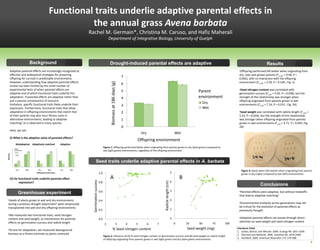
Ontario Biology Conference 2010
- 1. Functional traits underlie adaptive parental effects in the annual grass Avena barbata Rachel M. Germain*, Christina M. Caruso, and Hafiz Maherali Department of Integrative Biology, University of Guelph Background Drought-induced parental effects are adaptive Results Adaptive parental effects are increasingly recognized as •Offspring performed 6% better when originating from effective and widespread strategies for preparing dry- over wet-grown parents (F1,145 = 9.48, P = offspring for survival in predictable environments. 7 0.002), with no interaction with the offspring However, understanding how adaptive parental effects environment (F1,145 = 2.59, P = 0.109 ; Fig. 1) Biomass at 186 days (g) 6 evolve has been limited by the small number of experimental tests of when parental effects are •Seed nitrogen content was correlated with adaptive and of which functional traits underlie this 5 Parent germination success (F1,20 = 4.92, P = 0.038), but the adaptation. If parental effects are adaptive rather than 4 environment strength of this relationship was stronger when just a passive consequence of resource offspring originated from parents grown in wet limitation, specific functional traits likely underlie their Dry environments (F1,20 = 7.16, P = 0.015 ; Fig. 2A) 3 expression. Furthermore, functional traits that allow Wet adaptation in offspring environments that match that 2 •Seed weight was correlated with radicle length (F1,20 = of their parents may also incur fitness costs in 5.23, P = 0.034), but the strength of this relationship alternative environments, leading to adaptive 1 was stronger when offspring originated from parents matching1 as is observed in many species. grown in wet environments (F1,20 = 4.71, P = 0.043; Fig. 0 2B) Here, we ask: Dry Wet (i) What is the adaptive value of parental effects? Offspring environment Maladaptive Adaptively matched Adaptive 12 Parent 12 12 Figure 1: Offspring performed better when originating from parents grown in dry (dark green) compared to 10 environment 10 10 wet (light green) environments, regardless of the offspring environment Dry Biomass 8 8 8 Wet 6 6 6 4 2 4 2 4 2 Seed traits underlie adaptive parental effects in A. barbata 0 0 0 Dry Wet Dry Wet Dry Wet Figure 3: Seeds were 53% heavier when originating from parents Offspring environment 1.0 5 grown in dry (right) compared to wet (left) environments (ii) Do functional traits underlie parental effect A B Germination success 4 Radicle length (cm) expression? 0.8 Conclusions 0.6 3 •Parental effects were adaptive, but without tradeoffs Greenhouse experiment that lead to adaptive matching3 •Seeds of plants grown in wet and dry environments 0.4 2 during a previous drought experiment2 were reciprocally •Environmental similarity across generations may not transplanted into wet and dry offspring environments be critical for the evolution of parental effects as 0.2 1 previously thought •We measured two functional traits, seed nitrogen content and seed weight, as mechanisms for parental 0.0 0 •Adaptive parental effects can evolve through direct effects on germination success and radicle length selection on seed weight and seed nitrogen content 2 3 4 5 6 7 0 25 50 75 100 •To test for adaptation, we measured aboveground % Seed nitrogen content Seed weight (mg) Literature Cited 1. Sultan, Barton, and Wilczek. 2009. Ecology 90: 1831-1839. biomass as a fitness estimate as plants senesced 2. Sherrard and Maherali. 2006. Evolution 60: 2478-2489. Figure 2: Influence of (A) % seed nitrogen content on germination success and (B) seed weight on radicle length of offspring originating from parents grown in wet (light green) and dry (dark green) environments. 3. Hereford. 2009. American Naturalist 173: 579-588.